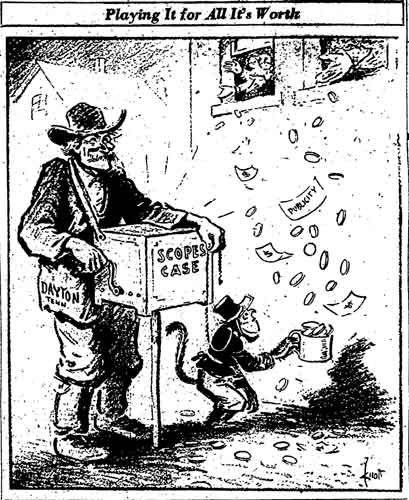History teaches us not to repeat our mistakes. I guess Texas BOE failed history class.
http://www.youtube.com/watch?v=ubWcr4bxWtM&feature=player_detailpage
In 1925, there was a trial of a Tennessee public school teacher, John Scopes. Scopes was said to have violated the state’s Butler Act which forbade teaching evolution. Scopes was convicted but later appealed and the judgment was overturned due to a technicality. The trial (also known as the Monkey Trial) was actually a publicity stunt in order to gain Dayton, Tennessee some attention. Scopes even convinced students to testify that he taught evolution in class. Regardless of this back story (which was unknown to me) this trial is a very important part in scientific history as well as that of the United States. It indirectly contributed to the National Defense Education Act as well as struck a blow to fundamental theologians. The video posted above is a collection of pictures and recordings from the actual trial as well as scenes from the 1960s movie, Inherit the Wind. Within the video you see and hear every major player in the trial including, William Jennings Bryan and Clarence Bryan.





 Nationalism is one of the causes of World War I. Nationalism is what made people become proud of their country. It also makes them support and fight for their country. Including imperialism and militarism, countries started to increase their armies power. Countries like Italy, Germany, Russia, and France became great powers. Nationalism encourage countries to be independent. Other countries that weren’t a great power like Serbia wanted to be independent because of Nationalism. They wanted to form their own country and be separate.
Nationalism is one of the causes of World War I. Nationalism is what made people become proud of their country. It also makes them support and fight for their country. Including imperialism and militarism, countries started to increase their armies power. Countries like Italy, Germany, Russia, and France became great powers. Nationalism encourage countries to be independent. Other countries that weren’t a great power like Serbia wanted to be independent because of Nationalism. They wanted to form their own country and be separate.





 In 1917, President Wilson’s administration came up with the CPI, or Committee on Public Information. What this committee did was it tried to manipulate the opinions of the public. They wanted to convince Americans to agree with America’s stance to go into World War 1. They did this by using “posters, newspaper advertisements, and motion pictures” to help spread the governments ideas. They also had Four-Minute Men who would go around trying to help sway the public’s opinions. These men targeted every audience, including most immigrant groups. In the end this committee proved very successful.
In 1917, President Wilson’s administration came up with the CPI, or Committee on Public Information. What this committee did was it tried to manipulate the opinions of the public. They wanted to convince Americans to agree with America’s stance to go into World War 1. They did this by using “posters, newspaper advertisements, and motion pictures” to help spread the governments ideas. They also had Four-Minute Men who would go around trying to help sway the public’s opinions. These men targeted every audience, including most immigrant groups. In the end this committee proved very successful.




 This is a picture of Henry Ford between 1863- 1947. Ford developed the techniques of production and marketing that brought in the reach of ordinary Americans. He established the Ford Motor Company in 1905. The Model T and assembly line innovations revolutionized American society and molded the world we live in today. Henry Ford used the assembly techniques to produce cars so that everyone can afford it.
This is a picture of Henry Ford between 1863- 1947. Ford developed the techniques of production and marketing that brought in the reach of ordinary Americans. He established the Ford Motor Company in 1905. The Model T and assembly line innovations revolutionized American society and molded the world we live in today. Henry Ford used the assembly techniques to produce cars so that everyone can afford it.






